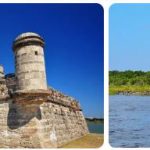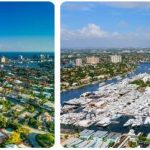
The state of Florida, also known as the Sunshine State, has a total area of 151,670 square kilometers. Florida is hemmed in by the Atlantic Ocean on the east, the Gulf of Mexico is its neighbor to the west, the north of the state borders the states of Georgia and Alabama, and finally, the Atlantic and Gulf of Mexico converge on the southern border. of the state. The state as a whole is lowland and intersected by rivers. In the south of the state, the temperatures are a few degrees higher than in the rest of the state, but throughout Florida there is talk of a tropical or subtropical climate. Throughout the year, the state is burdened by the sun and the accompanying temperatures.
According to EJIAXING, the state can sometimes suffer from rain and more often from hurricanes from the Caribbean. In winter, some snow can fall in the subtropical part, but absolutely not in the tropical part. The state has no less than 165 rivers and more than 30,000 lakes, of which Lake Okeechobee is the largest. The state has thirteen million inhabitants and the annual number of tourists is three times as high. In winter, hotel stays are the most expensive and reservations are not unwise. Reservations are also recommended in the summer, but the prices are then at least a bit more favorable. The capital of Florida is Tallahassee. Miami, Jacksonville, Fort Lauderdale, Tampa, St. Petersburg and Orlando are the state’s largest cities in addition to the capital. You will also find the smallest post office in America in Florida!
Biscayne National Park
Biscayne National Park is one of the largest coastal reserves managed by the National Park Service. The park consists for the most part of water with coral reefs in it. Also within the boundaries of the park are thirty-two uninhabited islands that are almost connected to each other and therefore resemble a cord from north to south. In 1980 this area received the status of National Park. Before this period it was a National Monument from 1969. The area of the park is 711 square kilometers. If one is planning to visit the coral reefs, this cannot be done without a boat. There is a tour boat that can accommodate a few guests and provides a tour of this area.
In the park you are offered the opportunity to see how the coral reef is formed. A coral reef consists of limestone skeletons of an infinite variety of invertebrates and unprotected animals that protect themselves by coating themselves with a layer of lime. It is often thought that coral reefs are plants, but nothing could be further from the truth. They are organisms that can reproduce by budding and branching. This is also why their limestone houses grow together and eventually form coral reefs. The reefs in the park are generally no deeper than 12 meters below the water. Many fish, plants and sea creatures survive here due to the fact that the coral reef provides them with food. Furthermore, the reef offers protection to the fish and there are also suitable places where their young have a chance to survive.
Dry Tortugas National Park
This park is located in the Gulf of Mexico about 115 miles west of the southern Florida town of Key West. The park can only be reached by boat or seaplane. The park consists of seven coral islands. These coral islands, known as the Keys, are collectively known as Dry Tortugasnamed. The group of islands was discovered in 1513 by the Spanish explorer Ponce de Leon. He named the islands Las Tortugas (the turtles) because of the large number of turtles that were housed there. Eventually the islands were named Dry Tortugas because there is no drinking water available. A lighthouse was built on Garden Key in 1825 because of the dangerous rocky shallows and sandbanks. The still working lighthouse was moved to Loggerhead Key in 1861.
In 1846, Garden Key began building a fort because of its strategic position. Fort Jefferson was never used for war purposes, however, and served as a Military Prison during the American Civil War. For example, this is where the conspirators of the assassination attempt on President Abraham Lincoln were held. The cells of these conspirators can be viewed in the fortress. In 1874, Fort Jefferson was completely cleared and in 1908 the area was given protected status to save the sea swallows from extinction. In 1992 the area became a National Park. Before that, it was called Fort Jefferson National Monument.
Everglades National Park
This probably best known, subtropical National Park is an untouched wilderness on the southwest tip of Florida. The park was granted status in 1947 and covers an area of 5663 square kilometers. The area is unique because of the vast areas of fresh and brackish water, mangrove forests, creeks, rivers, bays and plains covered with green swamp grasses. Where the name Everglades comes from is completely unclear. It is said that this area was marked as River Glades on earlier maps.
Later maps would indicate the name Everglades. The first-time visitor will initially wonder why the area owes its fame. It’s the little details that make the Everglades what they are. Small sights, smells and sounds, a fishing heron or an alligator lying in the sun. The details of this park can therefore not be viewed from the car. If you want to see something of this park, the only option will be to explore it via water and/or forest trails. The same climate prevails in the park almost all year round, with two distinctive differences, namely wet summers and dry winters. This does mean that the park is crowded all year round.
From the end of May to the end of October, severe storms bring heavy downpours. The warm, humid climate provides an abundance of insects. These are also an important link in the food chain. In the summer the water level in the park is quite high, so you will not find large groups of birds and other animals. Nevertheless, the summer months offer a lot of beauty: still waters, beautiful sunsets and beautiful vegetation. The winter season is perfect with few insects and nice and mild weather. Due to the lowered water level, various animals gather around watering holes and you can view this phenomenon without any problems.
Wildlife
The park has a name when it comes to the number of bird species that have been spotted in the park. There are more than three hundred different species. Endangered species that can be found in the park include the cougar, brown pelican, green sea turtle, peregrine falcon, American crocodile and manatee. The American alligator is one of the most famous wildlife inhabitants of the park. The poachers who saw a profitable business in the skins of the Alligator have reduced the number of Alligators considerably. But due to the protected status that the animals now enjoy, the number is steadily growing again. With a visit to Shark Valley you can come face to face with an alligator!
Extra information |
|
| state flower | orange blossom |
| state tree | palmetto palm |
| State bird | mockingbird |
| state bug | Zebra longwing butterfly |
Florida state slogan: The Sunshine State
Member of the union since: March 3, 1845








